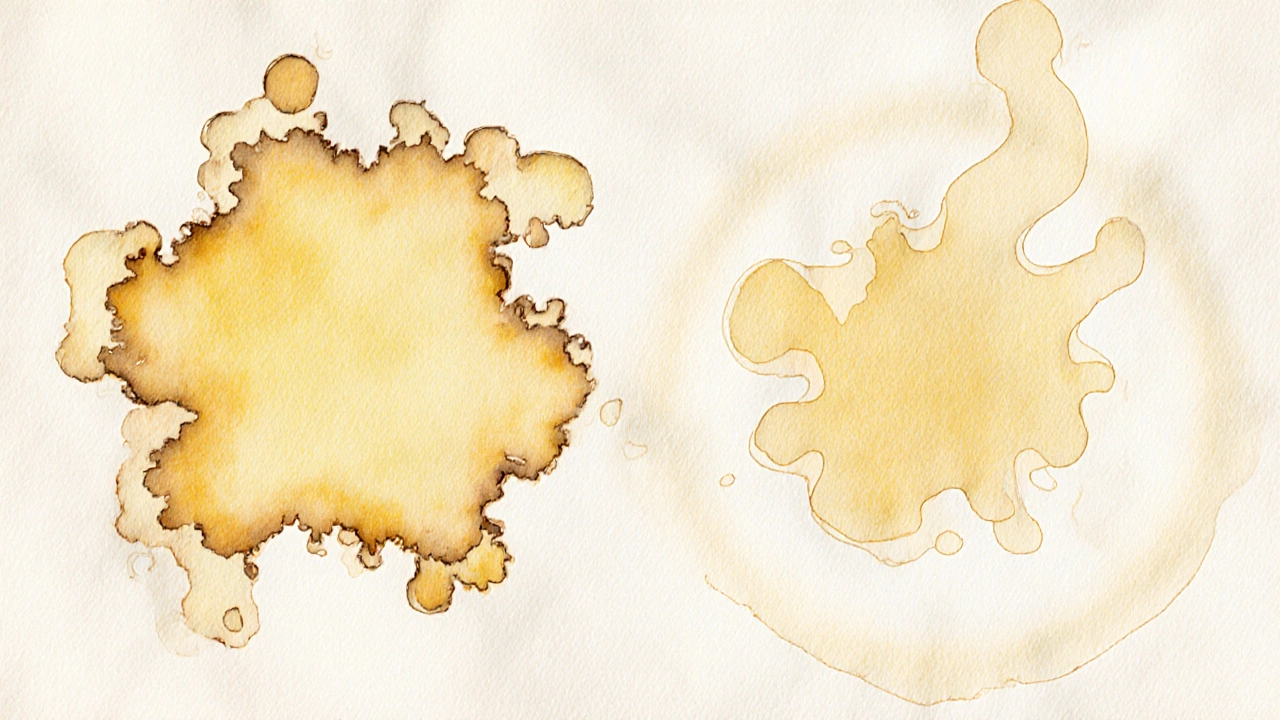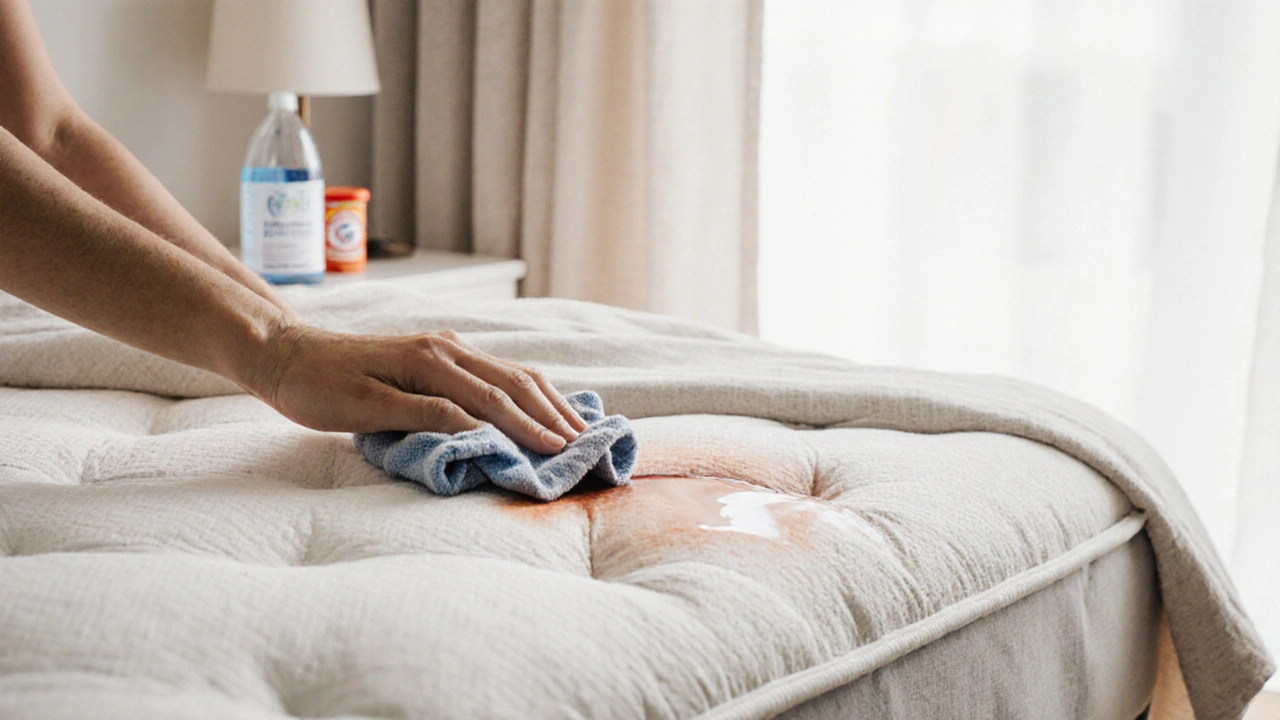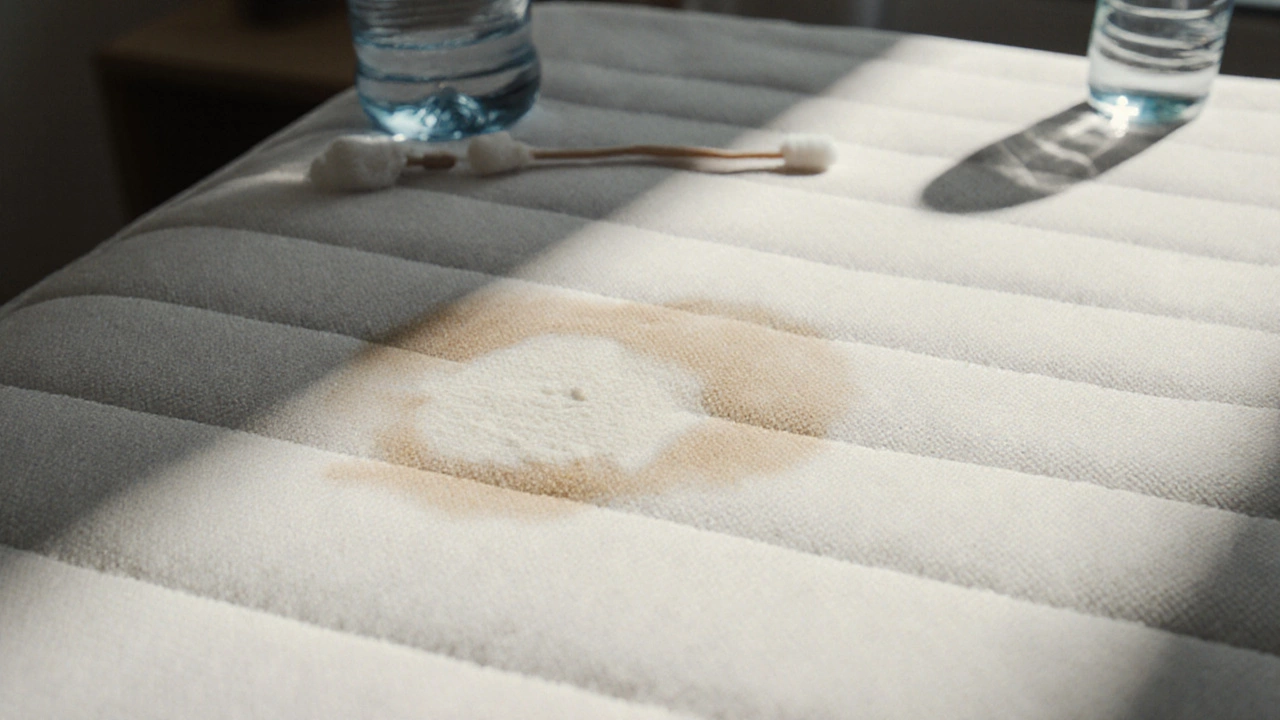Stain Identification Tool
This tool helps you determine if your mattress stain is likely sperm or vaginal discharge. Enter your observations below.
Result
Cleaning tip:
Finding a strange stain on your mattress can be unsettling. You might panic, wondering if it’s sperm, discharge, or something worse. The truth? Most of the time, it’s not either - but if you’re trying to figure out what you’re dealing with, you’re not alone. Many people ask this question after waking up to a damp or discolored spot, especially if they’re unsure what happened the night before. The good news? You don’t need a lab test to make a reasonable guess. With a few simple observations, you can tell the difference - and know how to clean it properly.
Visual Differences Between Sperm and Discharge Stains
Sperm and vaginal discharge look different when dried on fabric. Sperm is usually thin, milky white, and dries to a stiff, crusty texture. It often leaves a pale yellow or off-white mark that feels slightly gritty when you rub it. If you’ve ever seen dried semen on underwear, it’s the same kind of residue - not greasy, not sticky, just dry and flaky.
Vaginal discharge, on the other hand, varies by cycle and health. Normal discharge is clear to cloudy white, sometimes slightly yellow or cream-colored. When it dries on a mattress, it tends to leave a softer, more diffuse stain. It doesn’t harden like sperm. Instead, it often looks like a water ring or a faint, uneven smear. It might smell slightly sour or musky when fresh, but that odor fades quickly.
Here’s a quick visual guide:
- Sperm stain: Small, defined patch; stiff, chalky texture when dry; may have a faint, sweetish odor when fresh
- Discharge stain: Larger, blurred edges; soft, damp-looking residue; no hardening; may have a mild, natural scent
If the stain is large and spread out, it’s more likely discharge. If it’s small, round, and has a crusty edge, it’s probably sperm. But don’t rely on sight alone - smell and texture matter too.
Smell and Texture: The Real Clues
Odor is often the biggest giveaway. Fresh sperm has a faint chlorine-like or bleach-like smell because of its alkaline pH (around 7.2-8.0). It’s not strong, but if you sniff the stain right after it happens, you might notice it. That smell fades within hours.
Vaginal discharge has a naturally occurring odor - mild, earthy, sometimes like bread or yogurt. It’s not unpleasant unless there’s an infection. If the stain smells sour, fishy, or strongly metallic, it’s not normal discharge. That could mean bacterial vaginosis or a yeast infection, and you should consider medical advice, not just cleaning.
Texture is even more telling. Run your finger gently over the dried stain. If it flakes off like dried glue, it’s sperm. If it smears slightly and feels damp or powdery, it’s discharge. You can even test it with a little water. Dab a cotton swab with cold water and press it on the stain. Sperm will dissolve slowly and turn cloudy. Discharge will dissolve quickly and leave little to no residue.
Why It Matters for Cleaning
Knowing what you’re cleaning changes how you clean it. Sperm is protein-based. Hot water sets protein stains - it makes them permanent. That’s why using boiling water or a hot washer is a mistake. Cold water and enzyme cleaners work best. Enzymes break down proteins without damaging fabric.
Discharge is mostly water, salts, and cells. It’s easier to clean. A mix of cold water and mild detergent usually does the job. If there’s a lingering odor, sprinkle baking soda on the area, let it sit for an hour, then vacuum it up. Vinegar can help too - but never mix vinegar with bleach. That creates toxic fumes.
Here’s what to avoid:
- Hot water: Sets protein stains (sperm) forever
- Bleach: Damages mattress fabric and can cause yellowing
- Hydrogen peroxide: Can bleach the fabric, especially on memory foam
- Scrubbing hard: Pushes the stain deeper into the mattress core
Always test any cleaner on a hidden spot first. Mattress fabrics vary. Some are treated for moisture resistance. Others are porous. What works on cotton might ruin a bamboo cover.

What to Use for Cleaning
For sperm stains:
- Blot up excess with a dry towel - don’t rub
- Spray with cold water and let sit for 5 minutes
- Apply a small amount of enzyme cleaner (like Nature’s Miracle or Biokleen Bac-Out)
- Let sit for 15-20 minutes
- Blot again with a clean, damp cloth
- Let air dry completely - use a fan if needed
For discharge stains:
- Blot with a dry towel
- Make a solution of 1 cup cold water + 1 tbsp mild dish soap
- Dab the stain gently with a cloth soaked in the solution
- Rinse with a cloth dipped in plain cold water
- Sprinkle baking soda over the area
- Let sit overnight, then vacuum
Enzyme cleaners work on both. They’re safe for mattresses and break down organic matter without harsh chemicals. If you don’t have one, a mix of hydrogen peroxide and dish soap (in a 1:1 ratio) can help - but only on white or light-colored mattresses. Test first.
When to Call a Professional
Most stains can be handled at home. But if the stain is old, large, or has spread deep into the mattress, it’s time to call in help. Mattress cores absorb liquids. Once it’s soaked in, bacteria and odors can linger for months - even after you think it’s clean.
Professional mattress cleaners use steam extraction and UV sanitization. They can remove deep-set stains and kill allergens. If you’re dealing with recurring stains, or if you’ve tried everything and the smell won’t go away, a pro service is worth the cost. It’s cheaper than replacing a mattress.

Preventing Future Stains
Once you’ve cleaned it, protect your mattress. Use a washable, waterproof mattress protector. Not the cheap plastic kind - look for ones made with breathable, cotton-polyester blends. They let air through but block liquids. Wash them every two weeks.
Change your sheets weekly. Sweat, dead skin, and body oils build up fast. They can mimic the look of stains over time. If you notice dampness regularly, consider your hydration, diet, or hormone levels. Sometimes, increased discharge is normal - but if it’s sudden or accompanied by itching or burning, see a doctor.
And if you’re unsure what caused the stain? Don’t stress. Most people never know for sure. What matters is that you clean it properly and protect your sleep space. Your mattress doesn’t care if it’s sperm or discharge - it just wants to stay dry and clean.
Frequently Asked Questions
Can sperm stains turn yellow over time?
Yes. Sperm stains can turn yellow as they age, especially if exposed to heat or sunlight. This happens because proteins oxidize. Cold water and enzyme cleaners can still remove them, but the longer you wait, the harder it gets. Don’t let it sit more than a few days.
Is it normal to have a lot of vaginal discharge?
Yes - but only if it’s clear or white, odorless, and doesn’t cause itching. Discharge changes throughout your cycle. Around ovulation, it becomes clearer and stretchy, like egg whites. After your period, it may be thicker and white. If it’s green, chunky, smells bad, or causes discomfort, it could be an infection. Talk to a healthcare provider.
Can I use vinegar to clean a mattress stain?
Yes, but only diluted. Mix one part white vinegar with two parts cold water. Dab the stain, then rinse with plain water. Vinegar helps neutralize odors and break down organic matter. Never use it on silk, wool, or memory foam without testing first. Avoid mixing it with bleach or hydrogen peroxide.
Will a mattress protector stop these stains?
A good one will. Waterproof mattress protectors with breathable fabrics block liquids from soaking into the mattress. They’re the single best investment for mattress care. Wash them every two weeks and replace them every 1-2 years. They’re cheaper than replacing a mattress.
Can I use a steam cleaner on my mattress?
Only if your mattress manufacturer says it’s safe. Many memory foam and hybrid mattresses can be damaged by too much moisture. Steam can warp the foam or trap moisture inside, leading to mold. If you’re unsure, skip it. Use cold water and enzyme cleaners instead.
